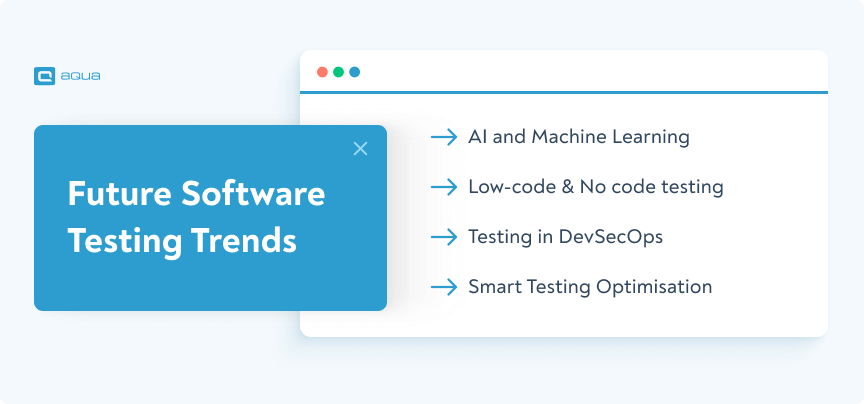Key Takeaways
- Software quality testing detects defects before release, with 88% of users abandoning products after experiencing just one major bug.
- The cost of fixing bugs increases exponentially across development phases, from €50 in requirements to €5000+ in production.
- Modern testing combines manual and automated approaches, with 77% of companies adopting automation for regression, performance, and load testing.
- AI-powered test management solutions like aqua cloud can reduce manual testing efforts by 43% and cut regression testing time by 34%.
- Risk-based testing prioritizes efforts on business-critical functions and high-impact areas where failures would cause the most damage.
Waiting until the last minute to test can lead to expensive disasters in production, but many teams still struggle with this approach. See how proper software quality testing can save your reputation and revenue in the article below 👇.
So, before this disaster happens, you need to have a thorough software quality assurance testing process in place. How? And what difficulties are on the way? This guide cuts through the fluff. Let’s get down to it.
What is software quality testing? (And why most teams do it wrong)
Software quality testing is the process of checking if software works as expected, without unexpected bugs, crashes, or security issues.
It is more than catching bugs – your goal should be to minimise it as much as you can. The ultimate goal is to prevent the bad code from being made to production.
What are the three pillars of software quality?
These are the main pillars of software quality:
- Quality Assurance (QA): Setting rules and best practices before development starts.
- Quality Control (QC): Finding issues after development through manual and automated testing.
- Testing: Running various tests throughout the development—unit, performance, security, etc.—to validate software quality.
🚨 Where QA teams fail: The main effort goes to fixing bugs after they make it to production. However, this is costly, bad for the reputation, and as stated above, one of the reasons why people abandon your software and never come back. You have to understand that testing is not an afterthought. Only then will you be able to minimise the number of bugs making it to the production. We will cover this in more detail further in this guide.
QA vs QC vs Testing: What are the differences?
Most people also use these three terms interchangeably. So, let’s clear this up fast:
- QA (Quality Assurance) = Preventing bugs
It’s about processes—setting up the right methods, standards, and checks so fewer defects make it into the code. Think audits, best practices, and continuous improvement. - QC (Quality Control) = Finding defects on the final product
It’s product-focused—reviewing requirements, testing builds, and verifying that the software meets specs before release. Happens after development. - Testing = The act of executing checks
An actual act of running tests (manual/automated) to catch defects.
Since testing is the primary way QC detects issues, it often gets mixed up. Understanding their differences is crucial so that you know QA is more than just testing. And you need testing in all parts of your software development lifecycle, not only after the launch where all bugs become 100x more expensive to fix.
The short answer is that software testing is just a small part of Quality Assurance.
Key Principles of Software Testing (That Most Teams Learn the Hard Way)
1. Early Testing: Don’t Wait Until It’s Too Late
Scenario: Your team just finished coding a major feature. QA gets it two days before release, runs tests, and—surprise—critical failures everywhere. Now it’s panic mode: Do you delay launch or ship broken software?
Reality: Testing should start the moment the first requirement is written. Review specs. Test prototypes. Validate architecture decisions. The earlier you catch flaws, the cheaper they are to fix.
2. Defect Clustering: The 80/20 Rule of Bugs
Scenario: After a release, 90% of your crash reports come from just two modules: the payment processor and file uploader. Your team wasted weeks testing low-risk features while the real time bombs slipped through.
Reality: In most systems, a small fraction of components cause most defects. Focus your testing firepower where it matters—historical data and risk analysis will show you where.
3. Pesticide Paradox: Your Tests Are Getting Obsolete
Scenario: Your automated test suite passes with 100% success… yet users keep reporting bugs. Why? Because you’ve been running the same tests for months, and they no longer catch new failure modes.
Reality: Like antibiotics losing effectiveness, tests wear out over time. Regularly review and expand your test cases—or risk missing critical regressions.
4. Context is Everything: Medical Software ≠ Gaming Apps
Scenario: Your team used the same testing approach for both a hospital patient portal and a mobile game. The game launched flawlessly, but the healthcare software failed compliance audits, costing $500k in fines.
Reality: Testing must match the stakes, regulations, and user expectations of your domain. What works for a social media app could be catastrophic for fintech or aviation systems.
5. Absence of Errors Fallacy: The Perfect Useless Product
Scenario: You shipped software with zero known defects… and users hated it. Why? Because you tested for “correctness” but never validated if it actually solved their problems.
Reality: No bugs ≠ good software. Assuming it means good software is one of the first red flags. If your product doesn’t deliver real value, technical perfection is meaningless. Always pair defect hunting with usability and market fit testing.
Software Testing Life Cycle Checklist You Need to Know
The STLC provides a structured approach to testing activities:
- Requirements Analysis: Understand what needs to be tested.
- Test Planning: Define testing strategy, effort estimation, and resource allocation.
- Test Case Development: Create detailed test cases and procedures.
- Test Environment Setup: Prepare the testing infrastructure.
- Test Execution: Run tests and report defects.
- Test Cycle Closure: Evaluate testing objectives against actual results.
Till now, we have come with theory. However, in practice, structured STLC is only as good as the solutions supporting it. Without a test management solution, your team will drown in spreadsheets, lose track of defects, and struggle with collaboration. Modern Test Management Systems (TMS) bring everything into one place—test cases, automation, reporting, and integrations. They make QA faster, smarter, and scalable. A prime example of these solutions is aqua cloud, an AI powered TMS that streamlines your STLC from the start.
Here is what aqua cloud helps you with:
- Requirements Analysis: AI-powered traceability ensures test coverage from day one.
- Test Planning: Centralised strategy and effort estimation streamline collaboration.
- Test Case Development: AI generates test cases and test data in seconds, reducing manual effort.
- Test Environment Setup: Seamless integrations with CI/CD pipelines, Jira, Azure DevOps, and automation frameworks.
- Test Execution: Manual and automated tests run side by side, with AI accelerating defect detection.
- Test Cycle Closure: Customisable dashboards and real-time analytics make reporting and insights effortless.
If your testing feels like a never-ending cycle of chaos, it’s time to upgrade to AI-powered test management with aqua.
Speed up every step of the software testing lifecycle with a 100% AI-powered solution
Testing Levels: From Unit to Acceptance
Software testing has multiple levels, each serving a specific purpose:
Unit Testing
Testing individual components in isolation. For example, a bank might test specific functions like interest calculation or fund withdrawal separately to identify issues early.
Integration Testing
Verifying interactions between integrated units. This makes sure different modules work together seamlessly.
System Testing
Testing the complete, integrated system to verify compliance with requirements.
Acceptance Testing
Validating the software meets business requirements and is ready for delivery.
Functional vs Non-Functional Testing
Functional Testing
Focuses on what the system does, including:
- Unit testing
- Integration testing
- System testing
- User acceptance testing
Non-Functional Testing
Examines how the system performs, including:
- Performance testing
- Load testing
- Security testing
- Usability testing
How do you know if you’re allocating your testing efforts correctly across these levels? Most teams guess, overspend on the wrong phases, and watch their budgets explode when bugs hit production. But what if you could simulate different strategies and see the real cost impact before making those expensive mistakes? We present to you a simulation exactly for this:
💰 The Bug Cost Escalator (Click to open) ▼
Discover how bug fixing costs escalate exponentially across development phases
Requirements
Baseline cost
Development
5x more expensive
Testing
15x more expensive
Production
100x+ more expensive
💡 Calculate your own costs
Key Takeaway
Manual vs Automated Testing: Finding the Right Balance
Manual Testing
Human testers execute test cases without automated tools, which is essential for:
- Exploratory testing
- Usability testing
- Ad-hoc testing
Automated Testing
Using specialised tools to execute tests, automated testing excels at:
- Regression testing
- Performance testing
- Load testing
The industry has seen a significant shift toward automation, with 77% of companies adopting automated testing. For nearly half of surveyed teams, automation has replaced over 50% of manual testing activities. But you still need a blend of both, because relying on only automation means risking a lot, and depending on only manual effort means losing on efficiency.
Does anyone think automation is very effective at finding bugs? Test automation finds content issues, environment issues, it’s own logical shortcomings. Actual software defects? Not so much.
Smarter Testing: Strategies That Actually Work
These are the proven strategies you need to implement in your testing efforts:
- Shift Left Testing: Find Bugs Before They Cost You
Waiting until the last minute to test? That’s how you get expensive disasters. Shift Left means testing as early as possible—even before a single line of code is written. Review requirements, validate designs, and automate early tests. The sooner you find issues, the cheaper they are to fix. - Risk-Based Testing: Focus on What Can Actually Break
Not all bugs are equal. A typo in a tooltip? Annoying. A broken checkout button? A financial nightmare. Risk-based testing helps you prioritise based on impact. Analyse past defects, business-critical functions, and security vulnerabilities—then focus your efforts where failure hurts the most. - Continuous Testing: QA That Moves at Dev Speed
If your tests only run before a big release, you’re already behind. Continuous Testing runs tests automatically with every code change, catching problems the moment they appear. Integrated into CI/CD pipelines, it ensures your software is always deployment-ready without slowing you down. - Test Data Management: Real Data, Real Insights
Testing with fake data leads to fake confidence. Poorly crafted test data misses real-world issues, especially in edge cases. Facebook’s A/B testing and other top-tier approaches use realistic, anonymized datasets to ensure testing reflects actual user behavior. The result? More accurate tests and fewer nasty surprises post-launch. - Metrics-Driven Approach: Measure What Matters
You can’t improve what you don’t measure. Tracking defect density (industry standard: ~1 defect per 1,000 lines of code), test coverage, and defect resolution time gives you hard data on QA effectiveness. A strong metrics strategy helps teams optimise testing efforts and prove QA’s impact to stakeholders.
Why You Need Test Management Solutions in Quality Assurance
Let’s be real—managing tests across spreadsheets, emails, and 15 different tools is a nightmare. Teams drown in chaos:
- Lost test cases buried in someone’s laptop
- Zero visibility on what’s actually tested
- Endless meetings just to figure out if you’re ready to ship
That’s where tools like aqua cloud step in. It does not just “manage tests”—it fixes the mess that slows you down every day.
What This Actually Does for You:
- Kills Spreadsheet Hell
- No more version 27 of “Test_Cases_FINAL_v2_revised.xlsx”
- All tests, results, and docs in one place—accessible to everyone
- Stops the “Who Tested What?” Circus
- Real-time dashboards show exactly what’s passed, failed, or untested
- No more surprises 2 hours before launch
- Works How Your Team Works
- Manual testers? Covered.
- Automation engineers? Plug your scripts right in.
- No forcing everyone into a rigid workflow
- Makes Decisions Based on Data, Not Guesses
- See trends: “Our payment module fails 73% of API tests—maybe we should fix that?”
- Prove QA’s impact with hard numbers (finally)
For instance, a German software company with a 9-digit valuation improved stability while maintaining biweekly releases using aqua cloud. They streamlined regression testing, improved QA efficiency, and cut regression testing time by 34%.
In banking, aqua’s AI-powered TMS reduced manual testing efforts by 43%, enabling financial institutions to launch new applications faster. A 140-year-old bank increased testing productivity by over 50% with aqua.
Want to join these companies and enter the list of success stories? Why wait?
Get the best testing services from 100% reliable, AI-powered test management solution
Future Trends in Software Quality Testing
Testing isn’t what it used to be. Relying on old-school methods while software development speeds ahead is a losing game. The industry is shifting—AI, automation, and smarter testing strategies are rewriting the rules. Are you keeping up?
Here’s where testing is heading and how you can stay ahead:
- AI and Machine Learning: Your New QA Superpower
AI isn’t hype—it’s revolutionising the game of testing. Imagine AI-powered test automation that writes, keeps up to date, and optimises tests for you. Smart defect prediction that points out threats before they become real issues. AI-driven test data generation that mimics real-world scenarios in seconds.
- Low-Code/No-Code Testing: Anyone Can Test Now
Not everyone on your team is a coding ninja. With low-code/no-code testing, product managers, business analysts, and even non-technical testers can create and execute tests without scripting. More testers result in faster feedback and fewer blind spots.
- Testing in DevSecOps: Catch Security Flaws Before Attackers Do
Security can’t be an afterthought. Integrating security testing into DevSecOps ensures that vulnerabilities are caught before deployment, not after a breach. Picture automated security scans, real-time threat detection, and continuous compliance checks—all built into your pipeline.
- Smart Test Optimisation: Stop Wasting Time on the Wrong Tests
Running every test every time? That’s inefficient. AI-based analytics can identify which test cases matter most. They can maximize coverage while removing useless runs. Fewer wasted cycles, faster feedback loops, and a more efficient QA process.

Aqua cloud’s AI Copilot lets you generate test cases, user stories, and BDDs instantly from requirements or files. Need test data? Get synthetic test data with precision and variety in seconds. Stuck on a testing challenge? AI-powered guidance helps solve complex issues fast. 100% traceability, test coverage, and visibility are not dreams far away anymore. With Jira, Azure DevOps, and automation integrations, you will supercharge your testing efforts. One-click bug-tracking integration Capture, customisable dashboards, and centralised repository gives you the ultimate software quality assurance testing experience. Step into the world of smarter testing today.
Transform your testing with a rock-solid, 100% modern, AI-powered solution
Conclusion
Software testing is no longer a final hurdle—it’s the centre of fast, reliable development. Modern apps are complex, and the cost of defects skyrockets the later they’re found. The smartest teams blend manual expertise with automation, use AI-powered tools like aqua cloud, and follow proven best practices to ship high-quality software faster. Investing in QA early will slash long-term costs by catching issues before they spiral. So the real question isn’t whether you can afford to test properly—it’s whether you can afford not to.


















